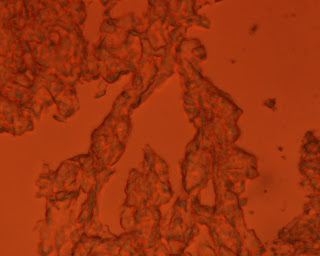1) What are the colour of the stained tissue?
Purple Pink
2) What is the pattern of colour distribution in the stained tissue?
Organelles are highlighted
3) Can you identify the nuclei of the cells? What colour are they?
Dark purple
4) Can you identify the cytoplasm of the cells? What colour are they?
Pink
5) What are the relative sizes and shapes of the cells in the tissue?
Irregular
6) How many different types of cells do you think there are in the tissue?
1
7) Are there any other observation you have identified? If so, describe them.
The cells are irregular (aka. Adhesion is bad)
Immunohistochemical Staining
1) What are the colours in the tissue?
Brown
2) What is the pattern of colour distribution in the stained tissue?
It is around the cell membrane.
3) Are the colour and distribution similar to that in the first slide?
No
4) The purpose was to determine the presence and location of a protein call vimentin. Which colour do you think represents vimentin? Why?
Brown
5) Describe the location of vimentin in the tissue
Cell membrane
6) What does the other colour represent?
Other organelles
7) Are there any other observation you have identified? If so, describe them.
Nope.
Fluorescence staining
1) Can you see the tissue using the fluorescence microscope? Does the tissue appear similar to the first and second slide?
No, it is now azure color.
2) Describe what you observe. How many colours appear when using the fluoresence micropscope and what is the colour?
1, it is just blue.
3) Are there any other observation you had identified? If so, describe them.
Not any special.





























